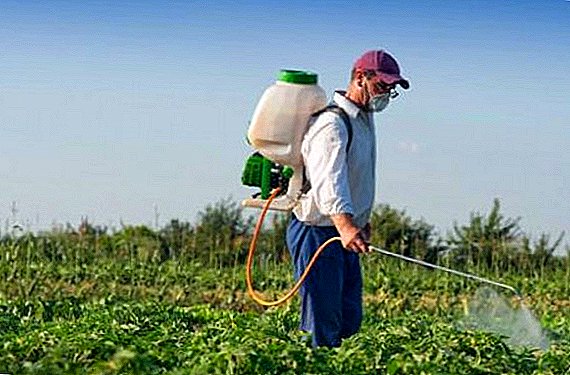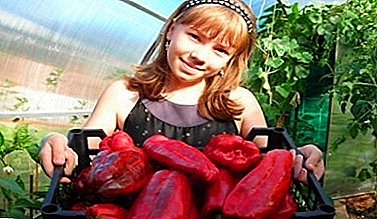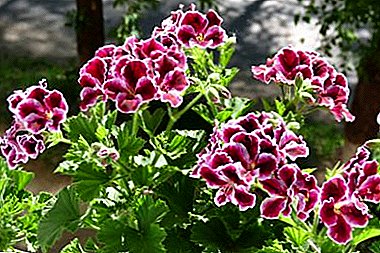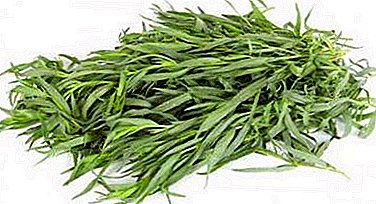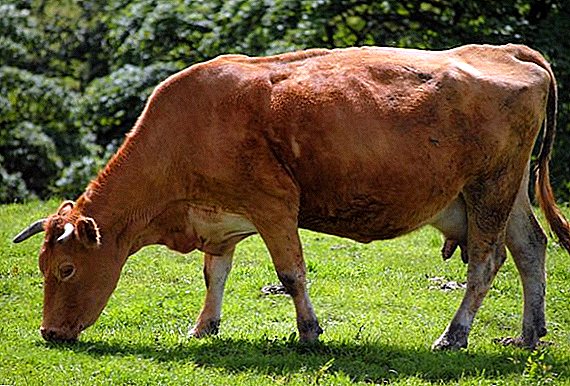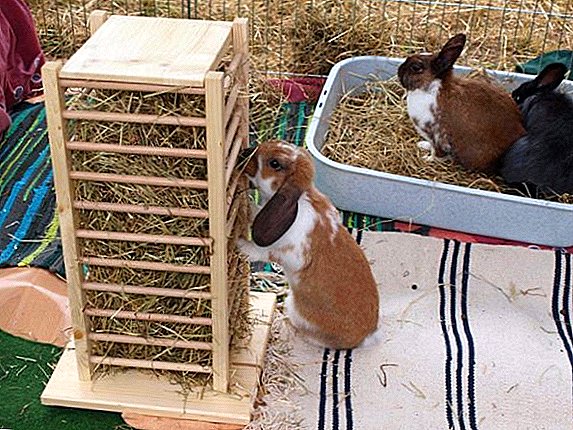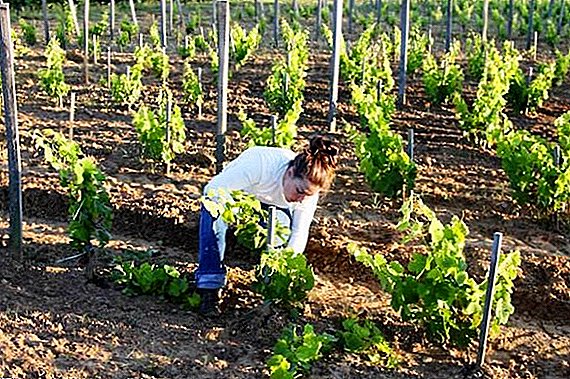 Grapes love and grow many. But to get a bountiful and good harvest, to uncover the nuances and "highlights" of each variety of this shrub, you need to ensure it is the right and careful care.
Grapes love and grow many. But to get a bountiful and good harvest, to uncover the nuances and "highlights" of each variety of this shrub, you need to ensure it is the right and careful care.
Let's find out the features of grape care at different times of the year.
Care for adult grapes after winter
So, let's start from the beginning of the season, that is, from the spring. Our grapes overwintered, and now it is necessary to prepare them for heat and a period of growth. 
Remove the shelter
The first issue to be resolved is the release of bushes from winter shelters. This should be done when the positive air temperature has finally been established. From experience, you can point out that the more to the north is the vineyard, the later the protection is removed.
In southern latitudes, you can start as early as April, in temperate climates, the beginning of May will be more suitable, and in the north you should wait until the end of May - the beginning of June. But long-term protection of the bushes can harm.
Therefore, it is best to remove the winter protection when the onset of heat, dry and air the vines, and then cover them again.
Did you know? The grapes were revered not only by the Greeks, but also by our Slav ancestors. In the Slavic pantheon, the fertility goddess Lada (or Alive) was present, holding an apple and a vine in her hands.

The sequence of the disclosure of grapes is as follows:
- The bush should be freed from the shelter before the onset of high temperatures, so that moisture does not accumulate and mold does not form.
- With late opening there is a risk of disclosure of the kidneys and sheets, which then disappear.
- With a high threat of night frost shelter is removed during the day, and put at night again.
- Bushes should be given access to the air, so that the plant gets used and hardened.
- Protection can only be removed after green buds have appeared and the threat of spring temperature extremes has passed.
Find out the most important about such grape varieties as Romeo, Alpha, Zest, Rusbol, Long-awaited, Valiant, Arched, Elegant, Tason, Yasya, Furor, Raspberry Super, Julian.
But it should be remembered that the main danger of night temperature drops are for growing kidneys. If the eyes are able to transfer frost to -3-4 ° С, then the buds that started their growth die at -1 ° С.
Therefore, at night, be sure to cover the grapes with non-woven material or lapnik. Such a spring shelter will protect from light frosts (up to -4 ° C) and will not prevent the earth from getting rid of excess moisture. 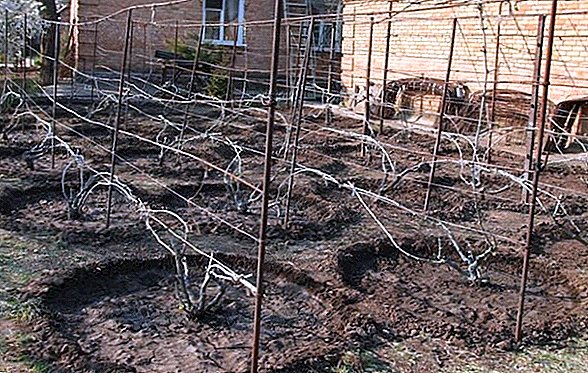
Important! Polyethylene film for spring shelters is not suitable.
Whether it is worth artificially warming up the soil after winter in your garden is up to you. You can cover plantings film. But it is worth remembering that you will not be able to maintain constant heat in your vineyard because of the high difference between the temperature inside and outside the greenhouse.
If in the spring you have an abundance of spring water, you should take care of the removal of excessive moisture. To do this, dig trenches at a distance of 0.7-1 meters from the bush in both directions. The trench width is two spade bayonets, depth 0.3-0.4 meters.
Extracted land must be written on the plant. In this way, you will get a raised bed and drainage outlets, along which excess water will flow in the right direction. Top, you can still sprinkle with organic mulch; this way you will get one more additional advantage - faster soil heating in spring. 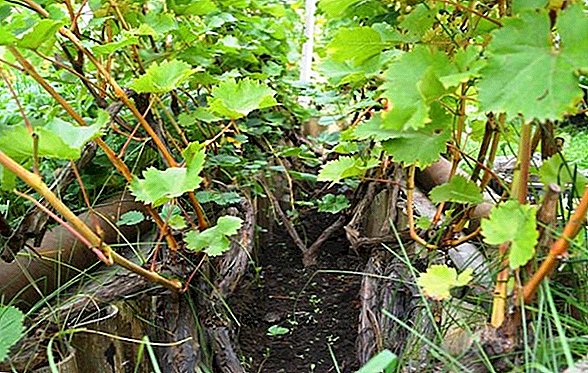
Inspect the grapes
The second need is a visual inspection of the bushes to detect problems.
After overwintering, some trouble may happen to the plant - it can be damaged by severe frost, the vine may have rotted or mold may appear. All this needs to be immediately detected and measures taken in order to avoid future troubles and crop losses.
Eyes can die in severe frosts and insufficient shelter, or in case of unexpected spring frosts.
To frost-resistant grape varieties include such as "Harold", "Valiant", "Romeo".
The percentage of damage is determined by selective germination of cut vines. According to the results of such a check, the number of holes left during trimming is determined.
A rotted or dried vine must be properly trimmed to save the entire shrub. All places of damage and wounds must first be treated with hydrogen peroxide, and then covered with garden pitch. 
Important! Watering and fertilizing damaged plants should be reduced by two to three times.
Upon completion of the inspection, the vines should be treated with a solution of copper sulfate - this will serve to protect against sudden frosts and the appearance of some diseases, like powdery mildew and gray rot.
How to prune grapes in spring
Grapes bear fruit only on a young vine, so regular pruning is a must. In addition, it stops such a phenomenon as the weeping of grapes - the excretion of juice in places of cut or damage.
You can not spare the bushes and cut them off by 90%. It does not hurt them at all, but on the contrary, it will rejuvenate and give strength for successful growth. 
- Pruning of annual shoots is carried out under the "zero" so that there is no hemp.
- Use a very sharp pruner, when pruning, place its emphasis on the vine to be removed.
- To remove the thick perennial shoots, use a sharp garden saw.
- Make the cut strictly perpendicular to the shoot; the cut should be as small, smooth and even as possible.
- Pruning is done from the inside of the vine - wounds heal in these places especially quickly.
It should be remembered a simple rule of pruning - the thicker and more the shoot, the longer it is cut. Small shoots are cut to a very small length. The fruitful vine is cut by 10-11 buds.
Learn more about the rules for pruning grapes in spring, as well as in summer and autumn.
After trimming the cut point, it is necessary to treat with hydrogen peroxide and cover it with garden pitch or red lead. This will protect the plant from infection by mold or fungi. 
Forming a bush
To carry out pruning should not aimlessly, and for the formation of the correct bush.
Did you know? In the world there are more than 10 thousand grapes. For example, there are about 4 thousand potato varieties.
To do this, remember:
- In the first year they grow one vine - strong and powerful, it will serve as a shoulder for further young lashes.
- The following year, three new vines are grown from the main arm with an interval of 80 cm. As a result, the length of such lashes should not exceed the indicated 80 cm. These will already be the sleeves, and it is on them that you need to further form new vines.
- From the third year we begin to actively form a bush. Remove all the kidneys on the shoulder and all but one of the strongest - on the sleeves. This is the skeleton of the bush.
- In subsequent years, it remains only to partially remove new shoots and form the bush that you want.

When forming two types are used:
- Standard alignment - used for varieties and areas that do not require shelter grapes. It is performed by forming one powerful shtamba and several sleeves on which the grapes will bear fruit. A stem is created by trimming 1-2 eyes of the first spring of one good shoot. The remaining whips are removed. In the second year, circumcision is performed again with 1-2 eyes and again all other whips are removed. In the third year, the resulting stem is cut to the required size, and two of the new vines are left (these are future sleeves), the rest are cut. Further work will be carried out with these arms - they are shortened according to the requirements of a particular variety, and fruit-bearing shoots are formed on them.
- Shaftless Alignment - It is used for covering grapes. The sapling is not shortened, and all shoots are bent and covered for wintering. In spring all shoots are pruned. This is repeated for three years.
Disease and pest treatment
After removing the cover and pruning the plant must be protected from possible diseases and pests. 
Do it in several stages:
- The first treatment is to eradicate spraying after the opening of the vine with iron sulfate (300-500 g per 10 liters of water).
- Swelling, disclosure of the kidneys - "Aktellik" (or "Bi58 new") and "Poliram". It is carried out, if the bush was ill last season.
- The third treatment - the end of April, 3-5 true leaves - "Chorus" (12 g per 10 liters of water) or "Topaz" and "Bi58 new."
Further processing is carried out before flowering, then - with the onset of fruiting.
Find out what and how to spray grapes in the spring from diseases, what drugs to use in the vineyard, how to deal with pests of grapes, and what to do if they appear on the grapes: grape pruritus, mildew, alternariosis, chlorosis.
Top dressing grapes in spring
For the full development and good growth of the shrub, many different trace elements and minerals are needed. 
In addition to the usual nitrogen, phosphorus and potassium, you need to add:
- copper - increases resistance to adverse weather conditions;
- boron - increases the sugar content in the berries, accelerates ripening;
- zinc - increases yields.
Be sure to add humus - it improves the structure of the soil, increases the permeability to air and water.
Fertilization is carried out in several stages.
- Before lifting the shelter, the grapes are watered with a solution of superphosphate (20 g / bush), saltpeter (10 g / bush), potash salt (5 g / bush).
- The same dosage of fertilizer is applied before flowering.
- After flowering and before the start of fruiting, you need to make phosphorus and potassium (20 g and 5 g per bush, respectively).
- Before winter, only potassium is added.
Learn how to feed grapes in spring and autumn.
Tillage and irrigation rules
The main objectives of spring tillage - preserving moisture and removing weeds. 
Need to start before removing the protection of the grapes. As soon as the earth dries, it can be loosened slightly to cover the accumulated moisture.
Later, the soil will need to loosen at least 5 times during the period of active growth of the vine. Loosening is carried out at a depth of 8-10 cm with simultaneous removal of weeds.
To prevent weathering from the surface of the beds, pristvolny circles should be covered with organic mulch. It will also serve as an additional fertilizer for grapes.
Grapes - a drought-resistant plant and the lack of moisture tolerates calm. Because in the spring there is no special need for watering. After all, moisture in the ground and so lacking. And its abundance will only destroy the bush. 
Here are some simple guidelines for watering a vineyard:
- It should be watered only in the case of hot weather and not more than once every 7-10 days.
- Watering is carried out in the drainage trench or special pits.
- Use warm distilled water.
- The main watering occurs at the time of flowering and ripening berries. Spring watering should be scanty.
Grafting and planting young grapes
In spring comes the time of planting the vineyard. Or you can plant a seedling on the already prepared stem.
Terms and rules of landing
Plant grapes need when the soil dries out and the threat of frost passes. The recommended soil temperature is more than 15 ° C, the air temperature is above 10 ° C.
For landing, choose a sunny place on a hill, preferably from the south. 
Important! Wetlands, lowlands, northern slopes are not suitable for growing.
Now it's time to make a hole. For grapes, it should be quite large - 80x80x80 cm. In such a pit, the bush will feel good and develop. At the bottom of the pit, add crushed stone for drainage and fertile land, 4-5 buckets of humus or compost, 0.5 kg of nitroammofosca and ash each.
All thoroughly mix and fill with earth to a level of 20 cm from the top edge. Water the soil with water and place the seedling with buds to the north, gently spreading the roots in all directions. Holding it at the top of the head, pour it over with earth, but do not tamp it down.
Familiarize yourself with the rules of planting grapes in the fall with saplings, cuttings and saplings in spring.
Plant the next stalk in 2-2.5 m.
The sapling needs a lot of moisture, so carefully monitor the condition of the soil and water when dry. 
How to plant grapes
Vaccination improves grapes resistance to diseases and adverse conditions. Usually grafted tender and whimsical varieties to more stable and hardy relatives.
The first operation will be harvesting cuttings for grafting. It is made in the fall, after harvesting, but before the onset of frost (usually October-November). Chubuks 9-12 cm long with two or three eyes are cut from the selected bush. Choose the tip of a healthy, even vine, and cut the chubuki out of it.
Learn more about how to plant grapes in spring and autumn.
The cut should be smooth and smooth, it should be done with a very sharp shears.
Important! In order not to confuse the top and bottom of the cutting, make the lower cut slightly bevelled, and the top - smooth.

Dip the finished cuttings in a 3% solution of copper sulphate for 30 seconds and then leave to air to dry. Wrap dry chubuki in a damp cloth or polyethylene and leave in a cold place (refrigerator, cellar) at a temperature of up to 5 ° C.
In the spring you can begin to vaccinate. It is carried out in good, but not hot weather, when the air temperature has exceeded 10-15 ° C - in April or in May.
There are several ways of vaccination - budding, underground butt fusion, splitting into an underground trunk. Beginners are recommended to use the latter method.  This vaccination is done as follows:
This vaccination is done as follows:
- Harvested cuttings are sharpened and for 2-3 days placed in a germinator solution (for example, "Epin").
- The selected stock (trunk, where cuttings will be grafted) is dug in by 15–20 cm and cleared of excess roots and bark.
- In the middle of the graft stem is split to the depth of the tip of the cutting (3-4 cm).
- A cutting is inserted into the split; if possible (the thickness of the trunk allows), you can insert another cutting in the other edge.
- The barrel is carefully wrapped with twine and covered with clay or garden pitch.
- The dug place is covered with earth.
Now you need to spud a new bush (you can add sand to the ground) and water it. Loosen and water regularly as the soil dries around the plant.  After 10-14 days new shoots should appear. If this does not happen - you need to cut the stock at the site of vaccination and repeat the procedure.
After 10-14 days new shoots should appear. If this does not happen - you need to cut the stock at the site of vaccination and repeat the procedure.
Regularly check how the accretion goes, and remove all excess roots that go past the rootstock.
Features care for a young plant
For a young bush you need to carefully care. It requires loosening and removing weeds. Watering is necessary as the land dries at the rate of 10 liters of water per bush.
Loosening is carried out carefully - so as not to damage the roots.
It is recommended to make katarovka for young plants in the first or second year of growth. By this word is meant cutting the roots that come to the surface. Thus, the stimulus to the development of the main root system is given.  The procedure is done once or twice a season: first at the end of June, the second time in a month - at the end of July or the beginning of August. To do this, the earth is torn around the bush to a depth of 12-15 cm. With a sharp knife, all the roots and rootstocks are cut.
The procedure is done once or twice a season: first at the end of June, the second time in a month - at the end of July or the beginning of August. To do this, the earth is torn around the bush to a depth of 12-15 cm. With a sharp knife, all the roots and rootstocks are cut.
How to care for grapes in summer
Of course, most work in the vineyard after the winter. But in the summer you can not let everything take its course - there is enough work at this time. In addition to the mentioned watering and loosening, in summer you need to take care of the beginning of forming new vines, proper feeding and protection.
Pinching, stepchild formation, leaf pruning
And the most important thing to take care of in the summer is a bountiful harvest. And to obtain it using several techniques.
One of them is pinching. 
Apply it on the green shoots of those varieties in which flowers can crumble ("Mattress", "Pearl Saba", "Gars Level", "Furmint", "Matyash Janosh", "Riesling").
The essence of the procedure - food should be sent to the flowers, and not to the growth of a new vine. To do this, a week before the grapes bloom, the point of growth breaks off on the young shoots.
Use a clothespin and for forming bushes. This is done at a time when the growth of the vine is still strong. They pinch it at the right height (usually a knot is left in 2 peepholes), and after a week or two, two new stepsons start to grow from the place of the cliff.
This is repeated during the first three years of bush growth - and in the third year there is already a ready fruiting bush.
Pinching grapes shoots: video
Three to four weeks before harvesting, thin out and trim the leaves. Old sheets that grow at the bottom of the bush and those that shade the grapes fall under the pruning. This pruning will improve the airing of the bushes and provide sun access to the berries, which will make them sweeter.
How to feed grapes in summer
In the summer, during flowering and ripening of the crop, grapes require a special approach to fertilizing with fertilizers. At this time, you need to cancel the nitrogen fertilizers and work only with phosphorus and potassium.
At the end of June, apply complex fertilizer - for example, azofosku or nitroammofosku - at the rate of 20 g per square meter of vineyard.
Important! All components of complex fertilizer must be water soluble! Otherwise, the roots of the plant will not be able to absorb them.
From the end of July to the beginning of August - the time of foliar dressing. 
To do this, dissolve in 10 liters of water:
- 1 liter of ash;
- 15-20 g of sugar;
- 1 g of boron;
- 1.5 g of copper.
Top dressing is carried out by spraying the underside of the leaves, preferably in the evening or early in the morning.
Disease treatment
The main peak of the fight against diseases of the grapes occurs in the spring. Именно при весенней обработке бордоской жидкостью минимизируется вероятность заражения кустарника основными болезнями.
In the summer, it is necessary to monitor the state of the foliage, so that at the first signs of a lesion to treat them with Bordeaux liquid or fungicide (Topaz, Strobe, Quadris will do). 
Additional pollination
Sometimes grapes need additional artificial pollination. It should be done twice: when blooming half of the buds and with full bloom. Work carried out in the morning, after drying out moisture, and finish before noon. If there is no sun and wind, you can work until the evening.
We will need:
- Glass jar. Rinse it with boiling water and dry before work begins.
- Fur coat First you need to rinse it. Puff made from winter fur rabbits or rabbits. This fur is treated, cleaned, disinfected and nailed to a wooden spatula.
Pollination is done like this:
- Pollen from inflorescences of bisexual flowers is shaken off in a prepared jar.
- The pollen collected by a puff is applied on inflorescences which need to be processed.
So, spring and summer care is generally uncomplicated, although it involves a lot of operations - removing shelters, inspecting, trimming, processing bushes. At the same time, you can plant new varieties on already established bushes. Proper and timely execution of all works will ensure a bountiful harvest in your garden.
Feedback from network users
The seedling should reach the tip of the fossa (remain recessed). The seedling should NOT reach the edge of the fossa by 20-30 cm. It will begin to grow, and in the fall to cut and fill the hole.



